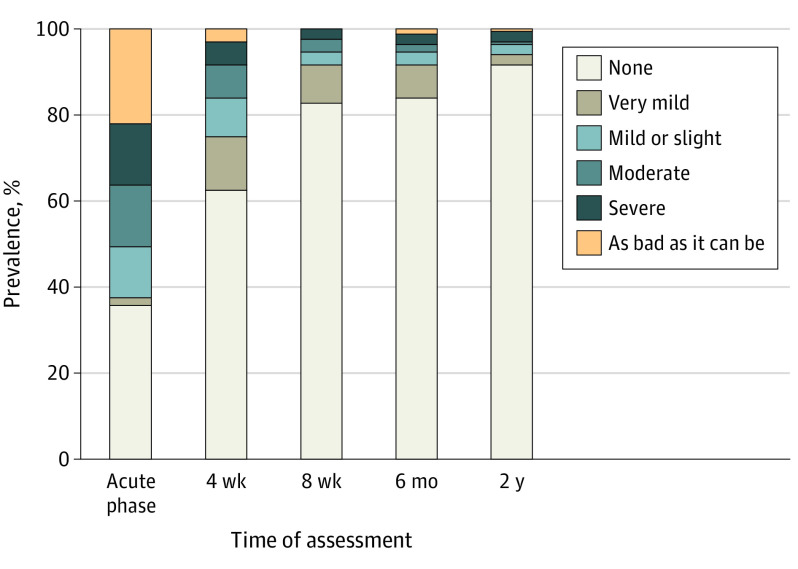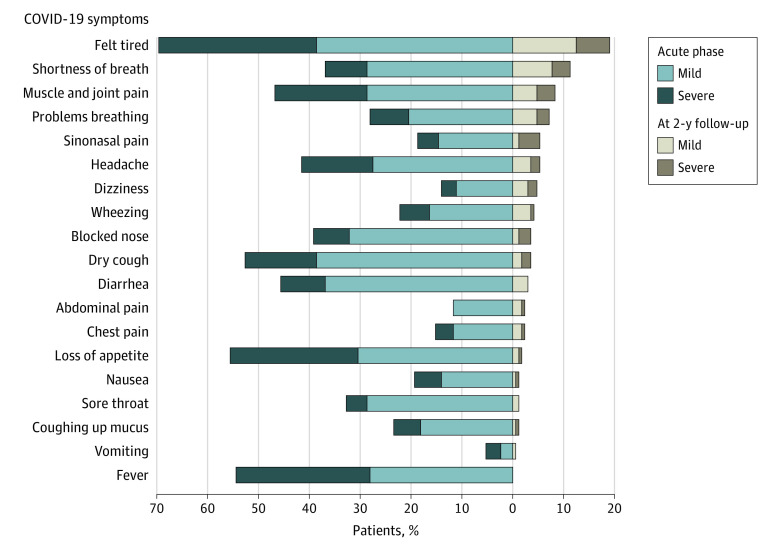Abstract
This cohort study estimates the 2-year prevalence and recovery rate of smell or taste dysfunction in patients with mildly symptomatic COVID-19.
Before the advent of the Omicron variant, smell and taste dysfunction were among the most commonly reported symptoms of mildly symptomatic COVID-19.1,2 Moreover, smell and/or taste dysfunction are prevalent symptoms of long-term COVID-19, with 7% of patients being functionally anosmic 1 year after SARS-CoV-2 infection.3 Given the high case rate of COVID-19, it is important to estimate the long-term persistence of these symptoms. We previously described the prevalence of an altered sense of smell or taste in mildly symptomatic patients at onset, 4 weeks, 8 weeks, and 6 months after COVID-19.1,4,5 The aim of the present study was to estimate the 2-year prevalence and recovery rate of smell or taste dysfunction in the same series of patients.
Methods
This cohort study was approved by the ethics committees of Treviso and Belluno provinces in Italy, and verbal informed consent was obtained from patients during telephone interviews. Adults 18 years and older who were consecutively assessed at Treviso General Hospital were included if they tested positive for SARS-CoV-2 by polymerase chain reaction on swab tests performed according to World Health Organization recommendation between March 19 and March 22, 2020, and who were considered suitable for home management. After assessment during the acute phase of the disease, the same patients were recontacted after 4 weeks, 8 weeks, 6 months, and 2 years. During subsequent interviews, the same questions were readministered. Symptoms were assessed using structured questionnaires, including the Acute Respiratory Tract Infection Questionnaire and Sino-nasal Outcome Test 22, as previously reported.1 Symptom prevalence was expressed as percentage of total patients, and 95% CIs were calculated using Clopper-Pearson method. Statistical analyses were performed using R, version 3.6 (R Foundation).
Results
Of 202 patients completing the baseline survey, 174 (86.1%) responded to all follow-up interviews. Three patients were excluded from the analysis owing to a documented reinfection with SARS-CoV-2, while 3 were excluded owing to late onset (>3 months) smell or taste dysfunction that suggested possible reinfection, thus leaving 168 (83.2%) eligible patients (median [range] age, 55 [20-89] years; 90 [53.6%] women). Among them, 108 (64.3%; 95% CI, 56.5%-71.5%), 64 (38.1%; 95% CI, 30.7%-45.9%), 29 (17.3%; 95% CI, 11.9%-23.8%), 27 (16.1%; 95% CI, 10.9%-22.5%), and 14 (8.3%; 95% CI, 4.6%-13.6%) reported an altered sense of smell or taste (Sino-nasal Outcome Test 22 score >0) at baseline, 4 weeks, 8 weeks, 6 months, and 2 years, respectively (Figure 1). Altered sense of smell or taste was first reported at 4-week follow-up in 11 patients when the swab test was still positive for SARS-CoV-2 infection. Among the 119 patients with onset of COVID-19–associated smell or taste dysfunction within 4 weeks, 105 (88.2%; 95% CI, 81.0%-93.4%) reported complete resolution at 2 years, 11 (9.2%; 95% CI, 4.7%-15.9%) reported a decrease in the severity, and 3 (2.5%; 95% CI, 0.5%-7.2%) reported the symptom was unchanged or worse; a late recovery (>6 months after the onset) was reported in 13 patients (10.9%; 95% CI, 5.9%-18.0%). At 2-year follow-up, the most frequent nonchemosensory symptoms (Figure 2) were fatigue (n = 31; 18.5%; 95% CI, 12.9%-25.2%), followed by shortness of breath (n = 18; 10.7%; 95% CI, 6.5%-16.4%). Overall, the persistence of at least 1 symptom at 2-year follow-up was reported by 47 patients (28.0%; 95% CI, 21.3%-35.4%).
Figure 1. Prevalence and Intensity of Altered Sense of Smell or Taste From Baseline to the 2-Year Follow-up in 168 Patients With COVID-19.
Severity of alteration of sense of smell or taste is according to Sino-nasal Outcome Test 22 item “sense of smell or taste.”
Figure 2. Evolution of Other COVID-19–Related Symptoms in 168 Patients.
Discussion
In this cohort study, 88.2% of patients reporting a COVID-19–related smell or taste dysfunction completely recovered within 2 years. A late recovery was observed in 10.9% of patients. Although these results must be interpreted with caution owing to study limitations (eg, data were self-reported based on a cross-sectional survey; outcomes not specifically validated for olfactory loss were used; a psychophysical evaluation of the chemosensory function was not performed; the sample was relatively small and geographically limited, with patients with more severe symptoms not included; data regarding potential treatments used for chemosensory impairment were lacking), contrary to what is often reported,6 patients should be reassured that recovery from smell or taste impairment may continue for many months after the onset. These results apply to patients infected in the pre-Omicron period. COVID-19 driven by the SARS-CoV-2 Omicron variant has been indeed observed to less frequently and less severely affect chemosensory function.2
References
- 1.Spinato G, Fabbris C, Polesel J, et al. Alterations in smell or taste in mildly symptomatic outpatients with SARS-CoV-2 infection. JAMA. 2020;323(20):2089-2090. doi: 10.1001/jama.2020.6771 [DOI] [PMC free article] [PubMed] [Google Scholar]
- 2.Boscolo-Rizzo P, Tirelli G, Meloni P, et al. Coronavirus disease 2019 (COVID-19)-related smell and taste impairment with widespread diffusion of severe acute respiratory syndrome-coronavirus-2 (SARS-CoV-2) Omicron variant. Int Forum Allergy Rhinol. Published online March 14, 2022. doi: 10.1002/alr.22995 [DOI] [PMC free article] [PubMed] [Google Scholar]
- 3.Boscolo-Rizzo P, Hummel T, Hopkins C, et al. High prevalence of long-term olfactory, gustatory, and chemesthesis dysfunction in post-COVID-19 patients: a matched case-control study with one-year follow-up using a comprehensive psychophysical evaluation. Rhinology. 2021;59(6):517-527. doi: 10.4193/Rhin21.249 [DOI] [PubMed] [Google Scholar]
- 4.Boscolo-Rizzo P, Menegaldo A, Fabbris C, et al. Six-month psychophysical evaluation of olfactory dysfunction in patients with COVID-19. Chem Senses. 2021;46:bjab006. doi: 10.1093/chemse/bjab006 [DOI] [PMC free article] [PubMed] [Google Scholar]
- 5.Boscolo-Rizzo P, Borsetto D, Fabbris C, et al. Evolution of altered sense of smell or taste in patients with mildly symptomatic COVID-19. JAMA Otolaryngol Head Neck Surg. 2020;146(8):729-732. doi: 10.1001/jamaoto.2020.1379 [DOI] [PMC free article] [PubMed] [Google Scholar]
- 6.Burges Watson DL, Campbell M, Hopkins C, Smith B, Kelly C, Deary V. Altered smell and taste: anosmia, parosmia and the impact of long Covid-19. PLoS One. 2021;16(9):e0256998. doi: 10.1371/journal.pone.0256998 [DOI] [PMC free article] [PubMed] [Google Scholar]




